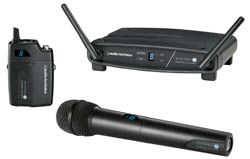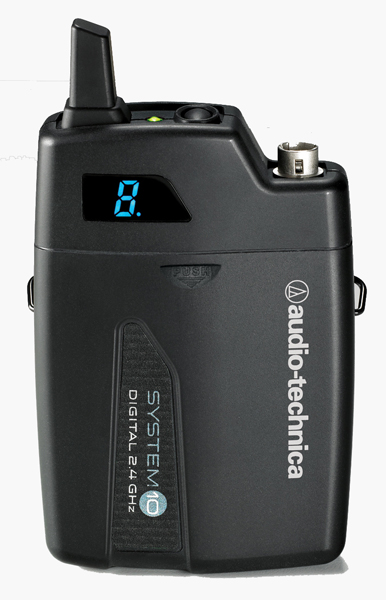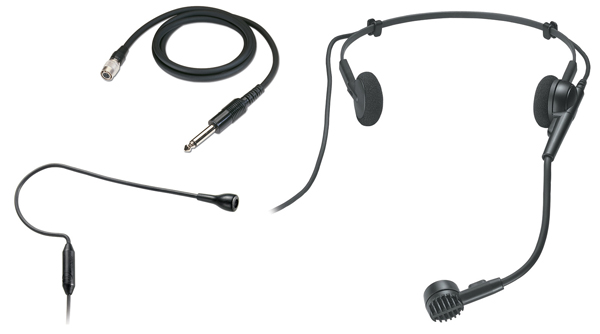
Attenuation at the rear of the mic is moderate, with the lows and mids still being picked up. Handling noise is acceptable.
The audio quality using the bodypack and the supplied PRO 92cW-TH omni headset was clean and uncolored with spoken word – the natural response I’ve often found in the new digital systems.
With an instrument cable, acoustic guitar reproduced the full range of the instrument with any resultant coloration coming from the pickup and amp combination, and compared favorably with a standard guitar cable.
System Components
The half-rack-sized ATW-R100 receiver was surprisingly light. Its construction is molded ABS, and the unit seems durable, with tight joints and good resistance to flexing.
The receiver is made for stand-alone use rather than rack-mounting. Permanently attached front-mounted antennas and stacking feet that fit into recesses on the top plate allow several units to share the same real estate.
The simple front panel provides a 1-character blue LED display, along with two buttons to select and pair channel ID numbers and two LEDs to indicate connection with the transmitter and audio overload.
The rear panel has balanced XLR and unbalanced quarter-inch connectors, with a rotary level control. The unit is powered with a compact external supply that takes up only one space within the power strip.
The ATW-T1002 handheld transmitter is durably built and somewhat hefty. It is attractively shaped and feels good in the hand, with a smooth matte finish that sometimes didn’t offer enough friction to keep the mic from slipping toward the head when I loosened my grip.
The only external control offered on this transmitter is an on/off/mute button on the butt end of the handle, adorned with the A-T logo. A touch and brief hold turns the transmitter on or off, and a quick touch will mute or unmute it.
The ATW-T1001 “UniPak” bodypack has a substantial feel while being fairly light in weight and moderately sized. The only external control is an on/off/mute button on the top surface next to the antenna. A Hirose-type connector is used, and A-T offers a variety of headset and lavalier mics in this format; third-party microphones are also available.
The battery cover encompasses much of the front surface, and becomes a functional design element. When I first attempted to open it I had a bit of difficulty, but after pressing the indentation molded into the top of the cover, it opened with a significant click and closed easily after I inserted batteries. I ran through this procedure several times, and it seems to be durable and not inclined to break or open unexpectedly.
Both transmitters have a level control to adjust the audio signal prior to transmission, and a small screwdriver is provided in the battery compartment for this purpose. The 10-milliwatt RF output power yields a typical operating range of 100 feet (30 meters). Battery life is greater than seven hours.
Conclusions & Pricing
With the System 10, A-T has achieved a plug-and-play digital wireless system that is simple for an inexperienced operator to use successfully when a handful of channels are required. Virtually all of the technical aspects of coordination are automated, and the multiple diversity methods keep the system performing well even in interference conditions. This is perhaps the easiest of the new digital systems to run.
A variety of system options and accessory microphones are available, with U.S. list prices ranging from $490 to $665.
Here’s a video tour of System 10 hosted by A-T’s Gary Boss:
Pro audio writer Gary Parks has worked in pro audio for more than 25 years, including serving as marketing manager and wireless product manager for Clear-Com, handling RF planning software sales with EDX Wireless, and managing loudspeaker and wireless product management at Electro-Voice.


